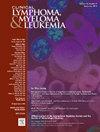SOHO State of the Art Updates and Next Questions: Treatment Options for Marginal Zone Lymphoma
IF 2.7
4区 医学
Q2 HEMATOLOGY
引用次数: 0
Abstract
Current classifications identify 3 primary types of marginal zone lymphoma (MZL): extra nodal, splenic, and nodal MZL. MZLs typically have excellent long-term outcomes and often do not require immediate treatment. For asymptomatic patients, active surveillance (watch-and-wait) is the standard approach. However, exceptions exist. Asymptomatic patients with Helicobacter pylori-positive gastric MZL should receive antibiotic eradication therapy upon diagnosis. Similarly, asymptomatic patients infected with hepatitis C virus (HCV) should receive antiviral therapy. Surgical resection is generally not indicated. Involved-site radiotherapy (ISRT) is recommended for localized disease (20-24Gy, depending on the anatomical site). While higher doses are often needed for curative intent, very low-dose ISRT (2×2 Gy) can achieve long-term control and provide effective palliation with minimal toxicity when a definitive cure is not the goal. Symptomatic patients with advanced-stage disease may benefit from systemic rituximab-based treatment. Rituximab monotherapy is suitable for patients who cannot tolerate chemotherapy or prioritize a low-toxicity initial approach. The combination of rituximab with bendamustine or chlorambucil can result in longer response duration and progression-free survival, but not in improved overall survival, and may be preferred for severely symptomatic patients with advanced disease. More intensive doxorubicin-containing regimens, which are more toxic, should be reserved for patients with histological transformation, aggressive presentations, or bulky masses. Although data from clinical trials are limited, several new therapies have shown encouraging results, including bispecific antibodies, chimeric antigen receptor (CAR)-T cell therapy, and small molecules. Treatment choices depend on the MZL subtype, stage, age, comorbidities, and therapeutic goals.
SOHO最新进展和下一个问题:边缘区淋巴瘤的治疗选择。
目前的分类确定了3种主要类型的边缘带淋巴瘤(MZL):淋巴结外型、脾型和淋巴结型MZL。MZLs通常具有良好的长期预后,通常不需要立即治疗。对于无症状患者,积极监测(观察和等待)是标准方法。然而,例外是存在的。无症状的幽门螺杆菌胃MZL阳性患者诊断后应接受抗生素根除治疗。同样,感染丙型肝炎病毒(HCV)的无症状患者也应接受抗病毒治疗。一般不需要手术切除。局部病变推荐采用受累部位放疗(ISRT) (20-24Gy,取决于解剖部位)。虽然通常需要更高的治疗剂量,但当最终治愈不是目标时,非常低剂量的ISRT (2×2 Gy)可以实现长期控制,并以最小的毒性提供有效的缓解。有症状的晚期疾病患者可能受益于全身利妥昔单抗治疗。利妥昔单抗单药治疗适用于不能耐受化疗或优先采用低毒初始方法的患者。利妥昔单抗联合苯达莫司汀或氯苯bucil可导致更长的反应持续时间和无进展生存期,但不能改善总生存期,可能更适合有严重症状的晚期疾病患者。含有阿霉素的强化治疗方案毒性更大,应保留给有组织学转变、侵袭性表现或大块肿块的患者。尽管来自临床试验的数据有限,但一些新疗法已经显示出令人鼓舞的结果,包括双特异性抗体、嵌合抗原受体(CAR)-T细胞疗法和小分子疗法。治疗选择取决于MZL亚型、分期、年龄、合并症和治疗目标。
本文章由计算机程序翻译,如有差异,请以英文原文为准。
求助全文
约1分钟内获得全文
求助全文
来源期刊

Clinical Lymphoma, Myeloma & Leukemia
ONCOLOGY-HEMATOLOGY
CiteScore
2.70
自引率
3.70%
发文量
1606
审稿时长
26 days
期刊介绍:
Clinical Lymphoma, Myeloma & Leukemia is a peer-reviewed monthly journal that publishes original articles describing various aspects of clinical and translational research of lymphoma, myeloma and leukemia. Clinical Lymphoma, Myeloma & Leukemia is devoted to articles on detection, diagnosis, prevention, and treatment of lymphoma, myeloma, leukemia and related disorders including macroglobulinemia, amyloidosis, and plasma-cell dyscrasias. The main emphasis is on recent scientific developments in all areas related to lymphoma, myeloma and leukemia. Specific areas of interest include clinical research and mechanistic approaches; drug sensitivity and resistance; gene and antisense therapy; pathology, markers, and prognostic indicators; chemoprevention strategies; multimodality therapy; and integration of various approaches.
 求助内容:
求助内容: 应助结果提醒方式:
应助结果提醒方式:


